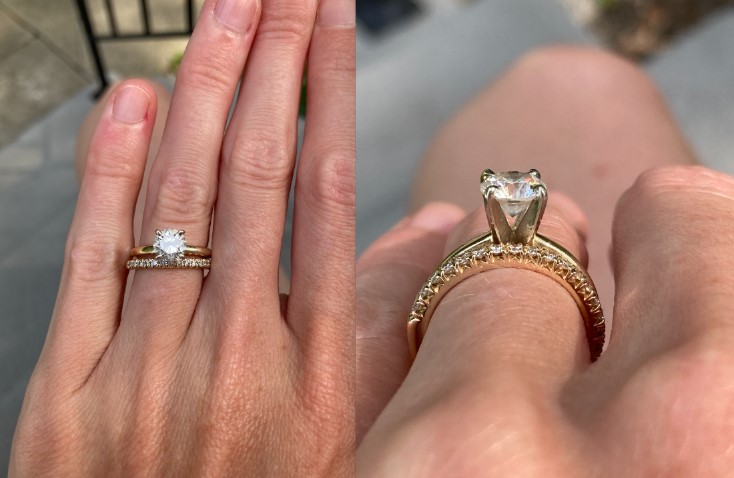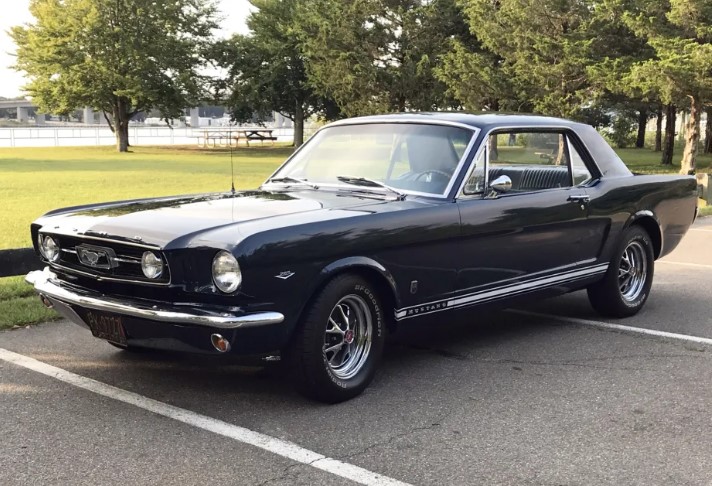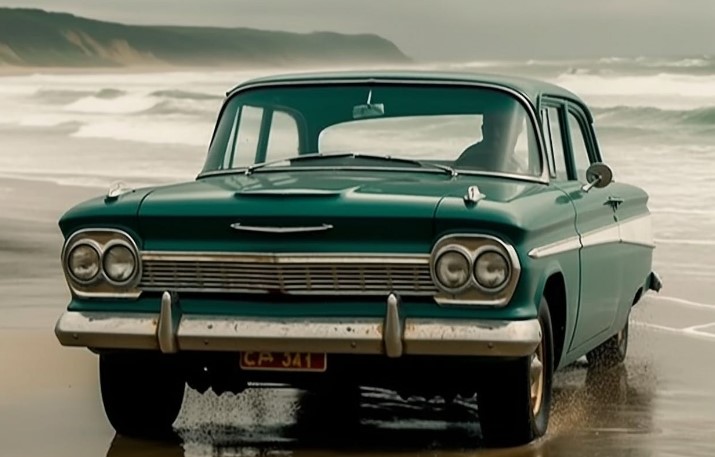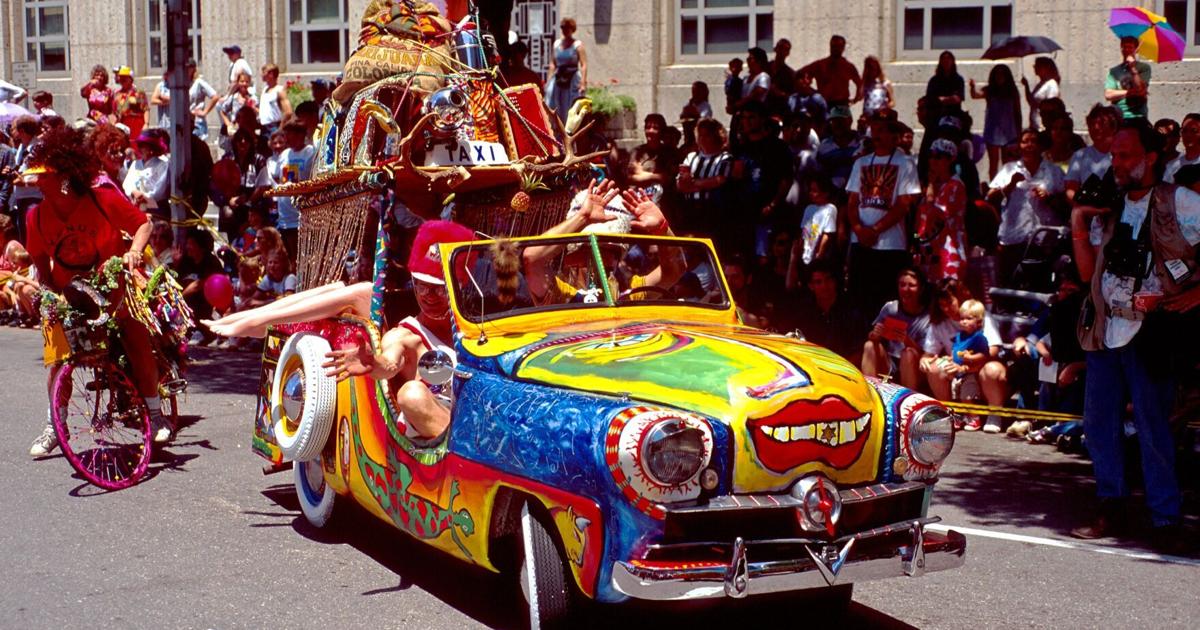It is unclear just when the unusual art phenomenon was born. Some credit Janis Joplin’s psychedelically painted 1965 Porsche. About the same time, John Lennon was driving a paisley Rolls Royce. Soon, many VW buses were being painted by the hippie generation.
“In our culture we are brought up to be respectful of our cars,” says Harrod Blank, an art car pioneer and expert. “But some see an automobile as just another factory-made commodity. To them it is an opportunity for personal expression. They turn their car into a work of art known as an ‘art car.’”
St. Louis is home to some famous automobiles in the art car world.
Jeff Lockheed, artist and the owner of the brightly decorated Venice Cafe, owns and painted the 1949 Crosley art car “Homage to Timothy Leary.”

For the last six years this St. Louis art car has been in storage. It was painted and decorated by Jeff Lockheed, the owner of Venice Café, who sits in the front seat in this 1999 photo.
“For the last six years it has been sitting in a warehouse. It needs a lot of work to get it running again,” he said recently, adding “it was sure a lot of fun when I had it as my everyday car. Just going to the grocery store was an event. I’d come out and there would always be a crowd.”
People are also reading…
Lockheed says in the 1990s there were about 12 art cars in St. Louis, and they would caravan to the annual art car parade held in Houston. “I am not sure why the younger generation has not embraced it,” he says.
Blank says many of the iconic art cars have been retired and are on display in one of the three art car museums in the country in Houston; Trinidad, Colorado; and Douglas, Arizona.

Harrod Blank poses in front of his Art Car World Museum in Douglas, Arizona. He is standing next to the Camera Van art car covered with 2,750 cameras, some of which are functional and take photos of the surprised onlookers.
The art car phenomenon does exist in other forms of transportation. Decorated art bicycles have been participating in the St. Louis Mardi Gras parade for decades, riding under the name of the Banana Bicycle Brigade.
“Some people turn boats, ATVs and motorcycles into art, too,” adds Blank, who lives in Arizona.
A well-known art bus in St. Louis belonged to the late Paul Pagano, a local personality known as “Father Time.” The bus was a fixture at parades, at sporting events and Fourth of July celebrations, and was decorated in red, white and blue. American flags adorned the top, and the sides were covered in hand painted slogans like “Don’t Worry, Be Happy.” A recording inside the bus of Kate Smith singing “God Bless America” was always playing. Pagano dressed as Uncle Sam and just enjoyed waving and talking to people.

Paul Pagano had an art bus in the late 1900s into the early 2000s that he would take to parades and sporting events in St. Louis. He died in 2016.
“I knew him well,” Blank recalls, adding that Pagano died in 2016. “He was a wonderful, gentle man, and one of the first to decorate a bus.”
“He was a hero to the St. Louis art car community,” Lockheed says. “It was a kick to follow him in traffic.”
The art car movement took off in the 1960s with untrained artists who had a desire to do something fun and interesting or to create art that has a special meaning, like dedicating the car to the memory of a lost friend or relative.
“They are usually the definition of an ‘outside artist,’ which is someone who creates art with no art training, often using recycled materials. They view a car as a blank canvas,” Blank says. (Pun intended.)

This art car was spotted in Cottonwood, Arizona, in January 2022. Covered with thousands of small plastic toys and figures, owner Julie Bower has dedicated a Facebook page to her “Toyz on the Hood” where she explains: “My car is a tribute to my parents who have passed. This was my mom’s last car and my dad was an art car artist in the ;60s and also a big-little kid which is where I got the theme.”
Blank has spent much of his life documenting art-car culture, producing a calendar, two books and two documentary feature films on the subject. He has made several art cars himself, all the while collecting some of the historically significant art cars instrumental in establishing the art form.
As far as Blank is concerned, art cars fall into two categories. Some are the only car the artist owns and are driven daily. Then there are those that are stored and only used on special occasions, such as a parade.
“There are fewer and fewer art cars being created now, although I estimate there are about 500 driven daily in the country,” Blank says. “The period from 1970 through the 1990s was really the time many of the better-known art cars were made. Many are now in museums. It was sort of a hippie thing, a rebellious art form and an artistic statement all at the same time.”
Some art cars are simply painted, mirrored or plastered with every kind of object from beads to coffee pots. Others are transformed into other shapes entirely, such as a rocket or a car with cameras covering every surface.

The Oh My God art car was one of the first and is now an iconic symbol of the art car movement. Created by Harrod Blank beginning in 1965 it is displayed at the Art Car World Museum in Douglas, Arizona.
Blank’s first art car was instrumental in the birth of the art car movement. The car began life as a 1965 white VW he purchased for $600 while he was in high school in Santa Cruz, California. “The kind of car you had, if you even had a car, was a big deal. I really wanted a Mustang but all I could afford was a $600 white 1965 VW Beetle,” he recalls. “Embarrassed to drive it, I painted a rooster on the passenger’s door — I was raising exotic poultry at the time. My popularity rose quickly, so I kept decorating.”
When Blank became infatuated with reggae music, paintings of Bob Marley and the Jamaican colors of red, gold and green were added.
Then, while studying anthropology in Mexico, Blank learned early humans responded to movement and color, and he started to add as many moving objects to the car as possible. Spinning sunflower windmills sprouted from the windows, and a flag on a pole was mounted on top. A world globe that lights up has sat precariously perched on the hood, and the bumpers were covered with a cornucopia of plastic fruit and plastic chickens.
Inside, the “chicken button” triggers the panicked recording of the disturbed birds, as if a fox were in the henhouse. A mailbox is on the roof, and a chalkboard hides the engine compartment in back so people can leave messages.
Eventually the entire car was covered in objects almost doubling its height, and it became known as “Oh My God!” — the No. 1 reaction from people who see it.
Another well-known art car is “Jewel Box.” The 1960 Chevrolet Corvair began its life after the death of Jay Battenfield’s wife in a traffic accident in Amarillo, Texas. Battenfield found it a therapeutic act of mourning to glue his wife’s jewelry to the car, regardless of the value. Examples include black diamonds, pearls, amethysts, rubies and jade jewelry.

Ron Snow of Paradise, California, added the likeness of a horse to his art car every time he wanted to take a drink after he was convicted of drunken driving. He credits AA meetings and his project of adding 1,400 horses purchased at flea markets and craft fairs with saving his life.
As he glued her jewelry and other mementos onto the car, it began to get attention in Amarillo, and people began to donate jewelry from their own deceased relatives.
Eventually Battenfield had to store the car in a secured semi-truck trailer.
Some art cars are the work of mainstream artists with established reputations. At automaker BMW, art cars have been a tradition every few years since 1975. American artists Alexander Calder, Roy Lichtenstein, Andy Warhol and David Hockney have all left their mark on different BMWs, some of which have been driven in competitive races like Le Mans.
But for the individual owner, Blank says an art car can lead to problems for the creator. “Some people are offended when they see an art car on the street,” he says. “They do not necessarily say nice things. Also, some seem to feel they can help themselves to the doodads of a car when there is a lot of stuff glued onto it.”
Another problem is that an art car is, after all, a car. The older it gets the more it costs to keep in running condition. That is what happened to Lockheed’s “Homage to Timothy Leary” car.

The Futuristic Zephyr art car is on display at the Art Cartopia Museum in Trinidad, Colorado.
Museums to visit
Art Car World: Douglas, Arizona
Harrod Blank’s museum displays 25 art cars In addition to his iconic “Oh My God.” Many are of historical significance and well-known to the art car community. Included are the Coltmobile and the California Fantasy Van.
The Coltmobile is covered in 1,400 blue horses, each added one at a time by creator Ron Snow whenever he wanted a drink. A recovered alcoholic, he credited the corral of horses on his car with saving his life.
Ernie Steingold of Burbank, California, spent more than 10 years welding his 1975 GMC Panel Van with money and brass-colored items. Steingold, who died in 1998, dedicated one side of his California Fantasy Van to his wife and the other to himself. Eventually the 15,000 pounds of added weight led to the demise of the car as a drivable automobile.
More info: Free, artcarworld.org
Alicia Dupas, the assistant director of the Art Car Museum, says this private institution “opened 1998 with an emphasis on art cars, but it also exhibits the work of other artists rarely acknowledged by other cultural institutions.”
The art car collection includes 20 automobiles, but only three or four are exhibited at once. “The cars are rotated about every 3 months when we also change the other art we display,” Dupas says.
Car artist David Best incorporated scrap-metal from junked cars into the distinctive silver exterior of the museum building, which features different turrets and spires resulting in the building being known as the “Garage Mahal.”
Houston is also home to the largest art car parade in the nation. Held each April for 35 years during a four-day weekend dedicated to art, the parade attracts 250 vehicles from 23 states, Canada and Mexico. The spectacle is watched by an audience of 250,000 onlookers.
More info: Free, artcarmuseum.com
Art Cartopia Museum: Trinidad, Colorado
Amanda Palmer is the curator of the newest art car museum, opened in 2018. The museum was established due to the unexpected success of ArtoCade, Trinidad’s yearly procession of wacky art cars, which began in 2012.
“The parade is dedicated to building community fun through the arts, and a way to attract visitors to town. Now we have over 100 cars that arrive from 15 states or more,” Palmer says.
“After the success of the parade we realized 12 art cars were here and stashed in garages around town, so we opened the museum. Now we have 25 on display.”
The collection includes the “Stink Bug,” a VW covered with cigarette butts collected as litter, and an Isuzu Trooper covered with glass and turned into a drivable mirror. A quirky vehicle with a large skeleton sitting on top driving a jet is the “Boney Whipman,” while “Cardi Gras” is covered in beads, pennies, Slinkys and other Mardi Gras memorabilia.
They are all under the watchful eyes of the “Eye Van,” which is covered in eyeballs.
Adding to what there is to see on wheels, there’s vehicle-based art on every wall and hanging from the ceiling.
According to the Cartopia website, the rules for entry into the Trinidad parade are simple: “If you can’t drive it, it’s a float. End of rules.”
More info: Free, artcartopia.com







More Stories
Investigation launched into complaints of Tesla steering wheels coming off mid-drive | Tesla
Wheels Car of the Year 2023: Finalists revealed!
Why Were so Many Built?